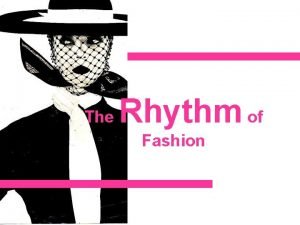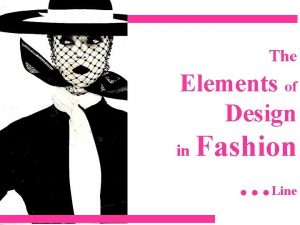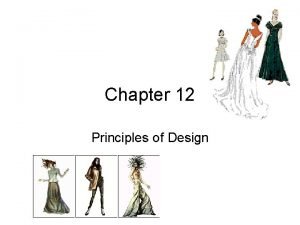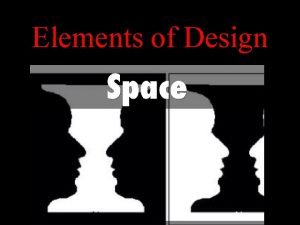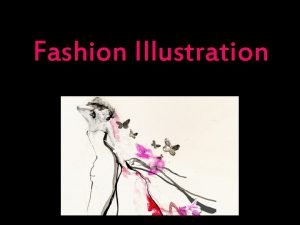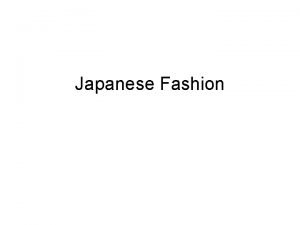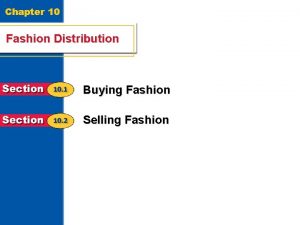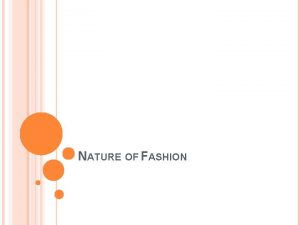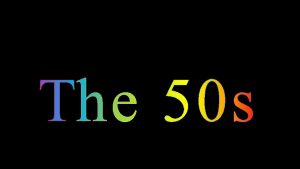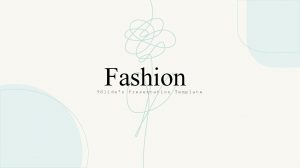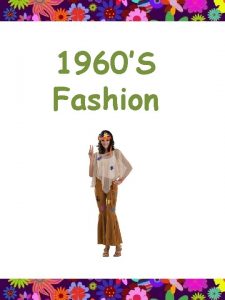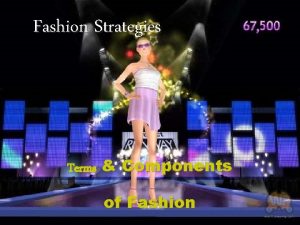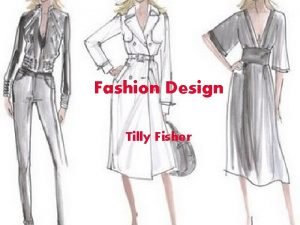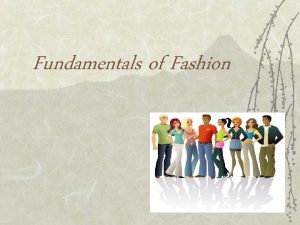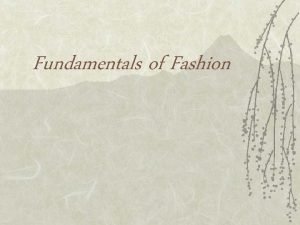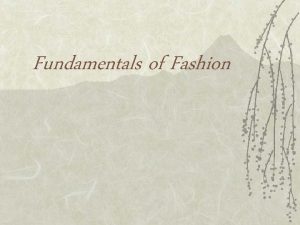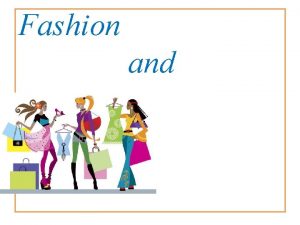FUNDAMENTALS OF FASHION DESIGN AFTER TAKING THIS COURSE


























- Slides: 26

FUNDAMENTALS OF FASHION DESIGN

AFTER TAKING THIS COURSE… Brief knowledge about the origin and history of fashion Basic understanding on Haute couture clothing Basic understanding on the terms used in fashion and fashion design Understanding the basics of different types of arts Basic knowledge about the materials used in fashion Identifying the roles of fashion designers in the fashion industry

CONT… Basic understanding on classifications of fashion and types of design Understanding design portfolio Basic understanding on elements and principles of design Basic understanding on design research and fashion design process

1. INTRODUCTION Textile and apparel industry products can be divided into two general categories: basic and fashion Basic products do not change radically from one season to the next, while the driving force behind fashion products is change. What is Fashion?

CONT… Fashion is defined as: 1. the prevailing or accepted style or group of styles in dress or personal decoration established or adopted during a particular time or season. 2. refers to fashion as such prevailing customs or styles considered as an abstract force whose integral components are novelty and change. 3. Fashion in the narrow sense of the world means the changing form of clothing.

CONT… These originate from peoples need to be adorned and admired and also to enhance personal style or indicate a position in society. The term “fashion” is frequently used in a positive sense, as a synonym for glamour and style. The terms "fashionable" and "unfashionable" are employed to describe whether someone or something fits in with the current popular mode of expression.

ORIGIN OF FASHION Today’s Fashion Industry roots reach far back into European history and are particularly evident when examining the evolution of aristocratic dress. For over 900 years, using expensive fabrics in dress has been important in order to reinforce superiority in the political and social structure. In the 17 th Century the French King Louis the 14 th, in addition to cultivating French leadership in matters of cuisine and decoration, King Louis the XIV’s court became the fashion center of Europe.

ARISTOCRATS Fashion: It defines your attitude and gives a strong indication of what to expect of you by the way you dress.

CONT… Fashion change, however, was extremely slow compared to today’s standards, taking years and sometimes decades before adoption of new styles. Before the mid-18 th century, there was a very strong division between the aristocracy and the common people, and the clothing people wore strongly reflected that division. Common people wore rough-hewn, simple clothing that lacked shape and color sometimes the urban common people who lived in towns around the castles were able to procure “hand-me-downs” from the aristocracy, but even those were usually in poor condition.

CONT… The contrast between the plight of the poor and the extravagancies of the court during the eighteenth century was one cause of the French revolution. In response to the general revulsion against excess, fashion changed from elaborately decorated costumes to simpler garments.

EFFECTS OF THE INDUSTRIAL REVOLUTION The industrial revolution marked the beginning of technological advancements in textile and apparel production. The modern textile industries enabled more fabric production with lesser time ever: - development of flying shuttle in 1733 - invention of spinning jenny in 1769 - invention of power looms in 1785

MASS PRODUCTION OF CLOTHING The mass production of clothing led to accessible fashion for everyone. The democratization of fashion began with the invention of sewing machine, which turned a handicraft in to an industry. The sewing machine made the mass production of clothing possible. - in 1829 a French tailor named Thimmonier invented a wooden chain stitch sewing machine. - An American inventor Elias Howe, in 1846 invented a sewing machine that was driven by hand.

CONT… - in 1859, Isaac Singer, developed the foot treadle sewing machine. (electrically powered models were not available until 1921). All these inventions made mass apparel production possible.

CONT… France became the center of fashion because of the patronage of the royal court and the development of the silk industry there. In France, the art of dress making was known as couture (koo-tour’). Charles Worth is considered as the father of the couture. Born in England moved to Paris at the age of 20 in 1846. The couture became a bridge between the class structured fashion of the past and the democratized fashion of today.

CONT… From these beginnings, an international market for Parisian high fashion grew. In 1868, the couturiers of Paris formed a trade association and they remained the major influence on fashion design for more than 100 years, setting style trends for all Europe, as well as the rest of the western world. T

WORLD FASHION INDUSTRY Fashion today is a global industry, and most major countries have a fashion industry. Some countries are major manufacturing centers, notably. Indonesia, Malaysia, Philippines, China, Bangladesh, South. Korea, Spain, Germany, Brazila nd India. Five countries have established an international reputation in fashion: France, Italy, the United Kingdom, the United States, and Japan

CONT… American fashion Industry The majority of American fashion houses are based in New York, although there also a significant number in Los Angeles, where a substantial percentage of high fashion clothing manufactured in the US is actually made. American fashion design is dominated by a clean-cut, urban, casual style; reflecting the athletic, healthconscious lifestyles of American city-dwellers.

CONT… A designer who helped to set the trend in the United States for sportinfluenced day wear throughout the 1940 s and 50's was Claire Mc. Cardell.

CONT… England fashion Industry London has long been the capital of the UK fashion industry and has a wide range of foreign designs which have integrated with modern British styles. Vintage styles play an important role in the British fashion and styling industry. Famous British brands include Burberry, Alexander and designers Mc. Queen, Mulberry, Stella Mc. Cartney and Vivienne Westwood.

CONT… French fashion Industry Most French fashion houses are in Paris, which is the capital of French fashion. Traditionally, French fashion is chic and stylish, defined sophistication, cut, and smart accessories. by its

CONT… Italian fashion Industry Milan is Italy's capital of fashion. Most of the older Italian couturiers are in Rome. However, Milan and Florence are the Italian fashion capitals, and it is the exhibition venue for their collections. Italian fashion features casual elegance and luxurious fabrics.

CONT… Japanese fashion Industry Most Japanese fashion houses are in Tokyo. The Japanese look is loose and unstructured (often resulting from complicated cutting), colors tend to the somber and subtle, and richly textured fabrics Famous Japanese designers are Yohji Yamamoto, Kenzo, Issey Miyake.

COUTURE Couture is simply the French word for fine, custom dress design, made to measure for a particular customer. A couturier is a male couture designer; a couturiere is his female counterpart. HAUTE COUTURE Haute couture is the type of fashion design which predominated until the 1950 s was "made to-measure" or haute couture, (French for high needlework).

Charles Frederick Worth (1826– 1895) The Father of Couture

CONT… The term Haute Couture can refer to: The fashion houses or fashion designers that create exclusive and often trend-setting fashions. The fashions created; Haute couture is made to order for a specific customer, and it is usually made from high quality, expensive fabric and sewn with extreme attention to detail and finish, often using time consuming, hand-executed techniques.

CONT… Haute couture, however, is a protected term which can only be officially used by companies that meet certain well-defined standards set by the Chamber Syndical de la Couture. A couture garment is made to order for an individual customer, and is usually made from high-quality, expensive fabric, sewn with extreme attention to detail and finish, often using time-consuming, handexecuted techniques.
 Fundamentals of fashion photography
Fundamentals of fashion photography After me after me after me
After me after me after me John 14:1-3
John 14:1-3 Impression taking course
Impression taking course Dental nurse impression course
Dental nurse impression course He probably loves (you) now
He probably loves (you) now![[author] java message service - jms fundamentals course [author] java message service - jms fundamentals course](data:image/svg+xml,%3Csvg%20xmlns=%22http://www.w3.org/2000/svg%22%20viewBox=%220%200%20200%20200%22%3E%3C/svg%3E) [author] java message service - jms fundamentals course
[author] java message service - jms fundamentals course Java message service
Java message service Sailor course brick
Sailor course brick Course number and title
Course number and title Chaine parallèle muscle
Chaine parallèle muscle Rhythm through continuous line movement
Rhythm through continuous line movement Line in fashion design
Line in fashion design Discuss what is structural design and decorative design
Discuss what is structural design and decorative design 4 types of decorative design
4 types of decorative design Opposition rhythm in fashion design
Opposition rhythm in fashion design Unit 8 fashion and design ielts answers
Unit 8 fashion and design ielts answers Math and fashion
Math and fashion Ci element
Ci element Fashion style vocabulary
Fashion style vocabulary Elements of design in fashion
Elements of design in fashion Apparel costing sheet
Apparel costing sheet Elements of design in fashion
Elements of design in fashion Positive space in fashion design
Positive space in fashion design Elements and principles of design fashion
Elements and principles of design fashion Duct design fundamentals
Duct design fundamentals Logic and computer design fundamentals
Logic and computer design fundamentals






![[author] java message service - jms fundamentals course [author] java message service - jms fundamentals course](https://slidetodoc.com/wp-content/uploads/2020/09/381247_2ef7a792adac8a30d3544ffd2fa051e8-300x225.jpg)




